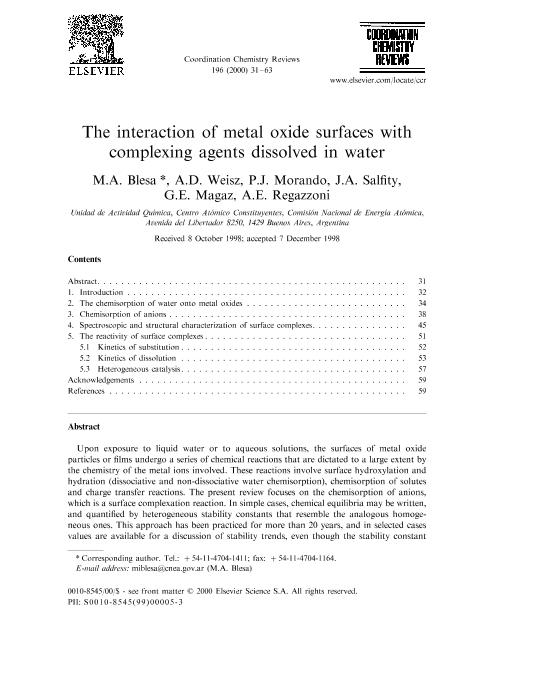Mostrar el registro sencillo del ítem
dc.contributor.author
Blesa, Miguel Angel

dc.contributor.author
Weisz, Ariel D.
dc.contributor.author
Morando, Pedro Juan

dc.contributor.author
Salfity, José Adrián

dc.contributor.author
Magaz, María del Carmen

dc.contributor.author
Regazzoni, Alberto Ernesto

dc.date.available
2019-03-14T18:28:53Z
dc.date.issued
2000-01
dc.identifier.citation
Blesa, Miguel Angel; Weisz, Ariel D.; Morando, Pedro Juan; Salfity, José Adrián; Magaz, María del Carmen; et al.; The interaction of metal oxide surfaces with complexing agents dissolved in water; Elsevier Science Sa; Coordination Chemistry Reviews; 196; 1; 1-2000; 31-63
dc.identifier.issn
0010-8545
dc.identifier.uri
http://hdl.handle.net/11336/71663
dc.description.abstract
Upon exposure to liquid water or to aqueous solutions, the surfaces of metal oxide particles or films undergo a series of chemical reactions that are dictated to a large extent by the chemistry of the metal ions involved. These reactions involve surface hydroxylation and hydration (dissociative and non-dissociative water chemisorption), chemisorption of solutes and charge transfer reactions. The present review focuses on the chemisorption of anions, which is a surface complexation reaction. In simple cases, chemical equilibria may be written, and quantified by heterogeneous stability constants that resemble the analogous homogeneous ones. This approach has been practiced for more than 20 years, and in selected cases values are available for a discussion of stability trends, even though the stability constant values are sensitive to double-layer modeling and to the history of the metal oxide used. Most of the stability constants have been derived in conventional ways from measurements of the corresponding adsorption isotherms, a procedure that does not provide structural information. Modeling of the shape and pH dependence of adsorption isotherms has been however used to propose various modes of adsorption, in order to derive, for instance, the speciation of surface complexes as a function of ligand concentration and pH. Presently, structural techniques are available to probe directly into the structure of the surface ensembles; the use of UV-vis, IR, magnetic and surface spectroscopies, together with EXAFS and SEXAFS has provided credence to the surface complexation approach, as discussed in the present review for selected cases. In particular, attenuated total refection FTIR has proved to be a powerful tool to derive the surface speciation in selected cases. The reactivity patterns of the surface complexes is being currently explored. The catalysis of ester hydrolysis, the rates and mechanisms of oxide dissolution, heterogeneous charge transfer reactions and the photocatalytic reactions of oxidation of organic compounds can all, in certain cases, be described as reactions of specific surface complexes; some relevant examples are discussed.
dc.format
application/pdf
dc.language.iso
eng
dc.publisher
Elsevier Science Sa

dc.rights
info:eu-repo/semantics/openAccess
dc.rights.uri
https://creativecommons.org/licenses/by-nc-sa/2.5/ar/
dc.subject
Chemisorption
dc.subject
Heterogeneous Catalysis
dc.subject
Metal Oxides
dc.subject
Oxide Dissolution
dc.subject
Surface Complexes
dc.subject.classification
Otras Ciencias Químicas

dc.subject.classification
Ciencias Químicas

dc.subject.classification
CIENCIAS NATURALES Y EXACTAS

dc.title
The interaction of metal oxide surfaces with complexing agents dissolved in water
dc.type
info:eu-repo/semantics/article
dc.type
info:ar-repo/semantics/artículo
dc.type
info:eu-repo/semantics/publishedVersion
dc.date.updated
2019-03-14T14:13:54Z
dc.journal.volume
196
dc.journal.number
1
dc.journal.pagination
31-63
dc.journal.pais
Países Bajos

dc.journal.ciudad
Amsterdam
dc.description.fil
Fil: Blesa, Miguel Angel. Consejo Nacional de Investigaciones Científicas y Técnicas; Argentina. Comisión Nacional de Energía Atómica. Centro Atómico Constituyentes; Argentina
dc.description.fil
Fil: Weisz, Ariel D.. Comisión Nacional de Energía Atómica. Centro Atómico Constituyentes; Argentina
dc.description.fil
Fil: Morando, Pedro Juan. Consejo Nacional de Investigaciones Científicas y Técnicas; Argentina. Comisión Nacional de Energía Atómica. Centro Atómico Constituyentes; Argentina
dc.description.fil
Fil: Salfity, José Adrián. Consejo Nacional de Investigaciones Científicas y Técnicas; Argentina. Comisión Nacional de Energía Atómica. Centro Atómico Constituyentes; Argentina
dc.description.fil
Fil: Magaz, María del Carmen. Consejo Nacional de Investigaciones Científicas y Técnicas; Argentina. Comisión Nacional de Energía Atómica. Centro Atómico Constituyentes; Argentina
dc.description.fil
Fil: Regazzoni, Alberto Ernesto. Consejo Nacional de Investigaciones Científicas y Técnicas; Argentina. Comisión Nacional de Energía Atómica. Centro Atómico Constituyentes; Argentina
dc.journal.title
Coordination Chemistry Reviews

dc.relation.alternativeid
info:eu-repo/semantics/altIdentifier/doi/https://doi.org/10.1016/S0010-8545(99)00005-3
dc.relation.alternativeid
info:eu-repo/semantics/altIdentifier/url/https://www.sciencedirect.com/science/article/pii/S0010854599000053
Archivos asociados
